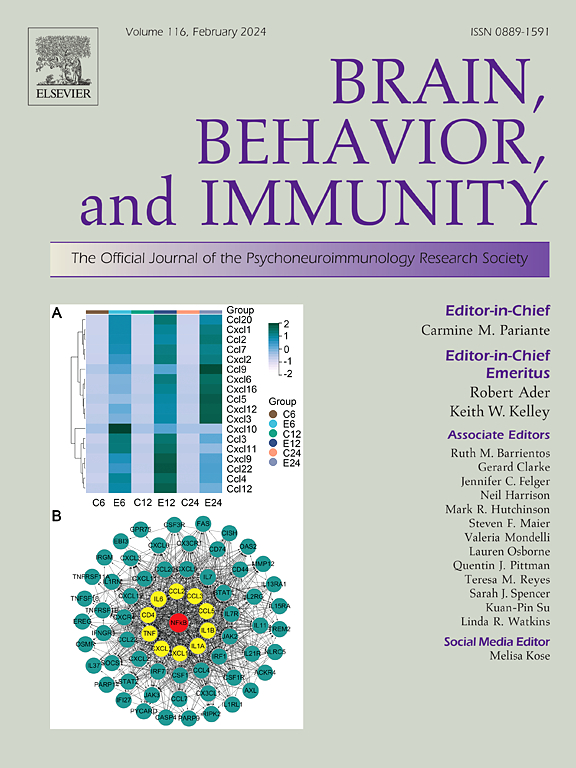鞘氨醇-1-磷酸受体3激活促进社交并调节对焦虑样行为重要的转录物。
IF 8.8
2区 医学
Q1 IMMUNOLOGY
引用次数: 0
摘要
我们之前已经证明,内侧前额叶皮层(mPFC)中的鞘氨醇-1-磷酸受体3 (S1PR3)可以防止通常由压力引起的社交能力下降。S1PR3是一种普遍表达的调节免疫系统功能的g蛋白偶联受体,尽管其对其他生物过程的调节尚不清楚。S1PR3的药理激活剂可能为理解社交性背后的神经基质提供重要的见解。本研究表明,在小鼠中,全身注射s1pr3特异性激动剂CYM5541可促进雄性和雌性的社交能力,而s1pr3特异性拮抗剂CAY10444可增加杏仁核激活并增加社交回避,尤其是在雌性小鼠中。S1PR3在雌性mPFC和齿状回的表达明显高于雄性。mPFC中的RNA测序显示,S1PR3激活改变了与免疫功能、神经传递、跨膜离子转运和细胞内信号传导相关的转录本的表达。这项工作提供了证据,证明S1PR3激动剂,传统上被用作免疫调节剂,也可能用于促进社会行为,并可能缓解社交焦虑症状。S1PR3可能是减轻应激不良影响的重要枢纽基因,因为它可以减少炎症过程,增加与焦虑性神经传递相关的转录本,并促进社会行为。本文章由计算机程序翻译,如有差异,请以英文原文为准。
Sphingosine-1-phosphate receptor 3 activation promotes sociability and regulates transcripts important for anxiolytic-like behavior
We previously demonstrated that sphingosine-1-phosphate receptor 3 (S1PR3) in the medial prefrontal cortex (mPFC) prevents reductions in sociability normally caused by stress. S1PR3 is a ubiquitously expressed G-protein coupled receptor that regulates immune system function, although its regulation of other biological processes is not well understood. Pharmacological activators of S1PR3 might provide important insights for understanding the neural substrates underlying sociability. Here we show that in mice, systemic injections of an S1PR3-specific agonist, CYM5541, promotes sociability in males and females whereas an S1PR3-specific antagonist, CAY10444, increases amygdala activation and increases social avoidance, particularly in females. S1PR3 expression is increased in the mPFC and dentate gyrus of females compared to males. RNA sequencing in the mPFC reveals that S1PR3 activation alters the expression of transcripts related to immune function, neurotransmission, transmembrane ion transport, and intracellular signaling. This work provides evidence that S1PR3 agonists, which have classically been used as immune modulators, might also be used to promote social behavior and, potentially, relieve symptoms of social anxiety. S1PR3 might be an important hub gene for mitigating maladaptive effects of stress as it reduces inflammatory processes, increases transcripts linked to anxiolytic neurotransmission, and promotes social behavior.
求助全文
通过发布文献求助,成功后即可免费获取论文全文。
去求助
来源期刊
CiteScore
29.60
自引率
2.00%
发文量
290
审稿时长
28 days
期刊介绍:
Established in 1987, Brain, Behavior, and Immunity proudly serves as the official journal of the Psychoneuroimmunology Research Society (PNIRS). This pioneering journal is dedicated to publishing peer-reviewed basic, experimental, and clinical studies that explore the intricate interactions among behavioral, neural, endocrine, and immune systems in both humans and animals.
As an international and interdisciplinary platform, Brain, Behavior, and Immunity focuses on original research spanning neuroscience, immunology, integrative physiology, behavioral biology, psychiatry, psychology, and clinical medicine. The journal is inclusive of research conducted at various levels, including molecular, cellular, social, and whole organism perspectives. With a commitment to efficiency, the journal facilitates online submission and review, ensuring timely publication of experimental results. Manuscripts typically undergo peer review and are returned to authors within 30 days of submission. It's worth noting that Brain, Behavior, and Immunity, published eight times a year, does not impose submission fees or page charges, fostering an open and accessible platform for scientific discourse.

 求助内容:
求助内容: 应助结果提醒方式:
应助结果提醒方式:


